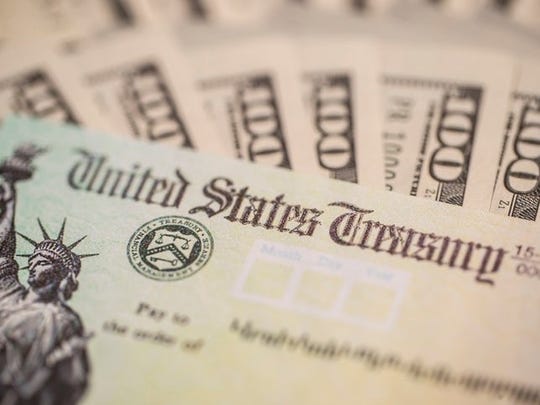Stimulus checks sent to 130M Americans so far. Delayed payments for some Social Security beneficiaries to roll out.
The Internal Revenue Service sent out COVID-19 relief checks to more than 4 million Americans the third round of payments made under President Joe Biden’s American Rescue Plan, the agency said Thursday.
That brings the total disbursed payments from the latest stimulus package to more than 130 million payments, worth about $335 billion. The payments, which total up to $1,400 each per individual, were distributed mostly by direct deposits and paper checks.
The third batch of payments began processing last Friday, with an official payment date of March 31, with some people receiving direct payments in their accounts earlier as provisional or pending deposits, according to the IRS.
Unemployment tax break: IRS tax refunds to start in May for $10,200 unemployment tax break: Here’s what you need to know
Where is my stimulus check?: Payments coming for some Social Security recipients and other federal beneficiaries, IRS says
The third batch of payments included more than 2 million direct deposit payments, with a total value of more than $5 billion. About 2 million paper checks were also sent out, totaling nearly $5 billion.
The checks in the third round also include “plus-up” payments for those whose income fell in 2020 compared with 2019. Payments to this group will continue on a weekly basis going forward as the IRS continues to process tax returns from 2020 and 2019, the agency said.
The payments will also go to those who the IRS didn’t previously have information on but have since filed their 2020 tax return.
Delayed checks coming for some Social Security recipients
The first two batches of payments went primarily to eligible taxpayers who provided direct deposit information on their 2019 or 2020 tax returns. That includes people who don’t typically file a return but who provided their information to the IRS last year through its online Non-Filers tool last year.
Starting Friday, payments will begin going to Social Security and other federal beneficiaries who didn’t file a 2020 or 2019 tax return and didn’t use the Non-Filers tool last year, the IRS said.
These payments will go to Social Security retirement, survivor or disability, Supplemental Security Income and Railroad Retirement Board beneficiaries.
“These payments will begin to be issued this weekend, with the projection that the majority of these payments will be sent electronically and received on April 7,” the IRS said in a statement.
(Photo: Getty Images)
What about VA beneficiaries?
The IRS is continuing to review data received for Veterans Affairs benefit recipients, the agency said. It expects to determine a payment date and provide more details soon.
It estimates that payments for VA beneficiaries who don’t normally file tax returns could be disbursed by mid-April.
The batch of stimulus checks that arrived this week include a ‘plus-up’ payment for those whose income decreased on their 2020 tax return compared to 2019.
Can I still qualify for a stimulus check?: Answers to your questions on COVID-19 relief, IRS tax refunds and more
IRS tax deadline: Retirement and health contributions extended to May 17, but estimated payments still due April 15
Who qualifies?
Some federal benefit recipients may need to file a 2020 tax return even if they don’t normally file to provide the IRS with information for any qualified dependent, the IRS says.
The third stimulus payment isn’t restricted to children under 17 like the first two rounds. Eligible families will get a $1,400 payment per qualifying dependent claimed on their tax return, including college students, adults with disabilities, parents and grandparents.
The payments amount to $1,400 for a single person or $2,800 for a married couple filing jointly, plus an additional $1,400 for each dependent child. Individuals earning up to $75,000 get the full payments, as will married couples with incomes up to $150,000. Payments decline for incomes above those thresholds, phasing out above $80,000 for individuals and $160,000 for married couples.
A Head of Household taxpayer isn’t eligible if their income is $120,000 or greater, although there is a phase-out between $112,500 and $120,000. Otherwise, a Head of Household will receive a $1,400 stimulus payment for themselves and each qualifying dependent with a Social Security Number, regardless of age, tax experts say.
How do I check the status of my payment?
Get updates on the status of your next stimulus payment using the IRS “Get My Payment” tool. To use it, enter your full Social Security number or tax ID number, date of birth, street address and ZIP code.
But the Get My Payment tool won’t be updated until this weekend with information for Social Security and other federal beneficiaries expecting payments next week, the agency said.
For those who are eligible, the tool will show a “Payment Status” of when the payment has been issued and the payment date for direct deposit or mail, according to the IRS’s frequently asked questions.
Source: Read Full Article


